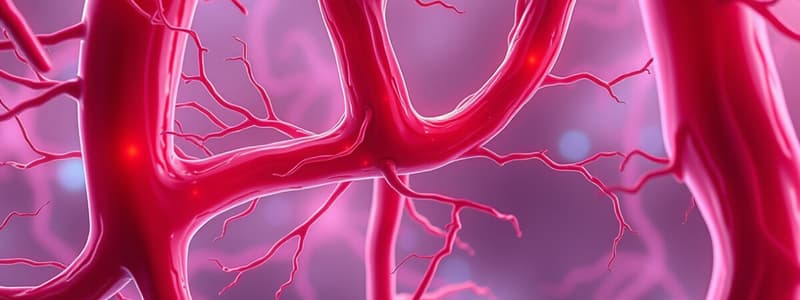Podcast
Questions and Answers
Match the type of blood vessel with its primary function:
Match the type of blood vessel with its primary function:
Arteries = Carry oxygenated blood away from the heart Veins = Return deoxygenated blood to the heart Capillaries = Facilitate exchange of nutrients and waste Arterioles = Regulate blood flow to tissues
Match the factor with its effect on tissue perfusion:
Match the factor with its effect on tissue perfusion:
Vasodilation = Increases blood flow to tissues Vasoconstriction = Decreases blood flow to tissues Increased heart rate = Enhances overall blood circulation Dehydration = Reduces blood volume and perfusion
Match the term with its corresponding factor affecting blood pressure:
Match the term with its corresponding factor affecting blood pressure:
Cardiac output = Volume of blood the heart pumps in a minute Total peripheral resistance = Resistance blood encounters in vessels Blood volume = Total amount of blood in the circulatory system Viscosity = Thickness of the blood affecting flow dynamics
Match the type of control with its function in the cardiovascular system:
Match the type of control with its function in the cardiovascular system:
Match the major vessel with its location in the systemic circulation:
Match the major vessel with its location in the systemic circulation:
Flashcards are hidden until you start studying
Study Notes
Structure and Function of Blood Vessels
- Arteries: Thick-walled, elastic vessels that carry oxygen-rich blood away from the heart; high pressure results in a narrower lumen.
- Veins: Thinner walls than arteries, larger lumen, contain valves to prevent backflow; primarily transport deoxygenated blood back to the heart under lower pressure.
- Arterioles: Smaller branches of arteries that regulate blood flow into capillary networks; muscular walls allow for changes in diameter which influence blood pressure.
- Capillaries: Microscopic vessels with thin walls composed of a single cell layer; facilitate exchange of oxygen, carbon dioxide, nutrients, and waste products between blood and tissues.
Tissue Perfusion and Capillary Exchange
- Tissue Perfusion: Adequate blood flow to tissues is necessary for nutrient delivery and waste removal; influenced by blood pressure and vessel diameter.
- Capillary Exchange Factors:
- Hydrostatic pressure pushes fluid out of capillaries into tissue.
- Osmotic pressure draws fluid back into capillaries, balancing fluid movement.
- Factors such as inflammation can increase permeability, allowing more substances to pass.
Blood Flow, Resistance, and Blood Pressure
- Blood Flow: Volume of blood that circulates through the blood vessels in a given period; influenced by the heart's pumping action and the diameter of the vessels.
- Resistance: Opposition to blood flow due to vessel diameter, length, and blood viscosity; higher resistance decreases flow and can affect blood pressure.
- Blood Pressure: Force exerted by circulating blood on vessel walls; measured as systolic over diastolic pressure.
- Nervous Control: Autonomic nervous system regulates heart rate and vessel diameter to adjust blood pressure.
- Hormonal Control: Hormones like adrenaline and angiotensin II can constrict or dilate blood vessels, influencing blood flow and pressure.
Major Clinically Relevant Vessels in Systemic Circulation
- Aorta: Largest artery, originating from the heart, distributing oxygenated blood to the entire body.
- Pulmonary Veins: Return oxygenated blood from the lungs to the heart.
- Superior and Inferior Vena Cava: Major veins transporting deoxygenated blood from the body back to the heart.
- Carotid Arteries: Supply blood to the head and neck; clinically significant in stroke assessment.
- Coronary Arteries: Supply the heart muscle; blockage can lead to coronary artery disease.
- Lymphatic Vessels: Part of the immune system, transporting lymph fluid; collect excess interstitial fluid and return it to the circulatory system.
Studying That Suits You
Use AI to generate personalized quizzes and flashcards to suit your learning preferences.




